Building your own solar fruit dehydrator today puts you in control of your food preservation while saving over $500 annually on energy costs. You'll reduce your environmental footprint by using free solar power instead of electricity, and you can preserve excess produce that might otherwise go to waste. A basic model costs under $50 to build but lasts 10-15 years, providing exceptional value for your investment. You'll enjoy nutritious dried fruits and vegetables year-round, knowing exactly how your food was preserved. The benefits of sustainable food preservation extend far beyond your kitchen walls.
The Power of Solar Preservation
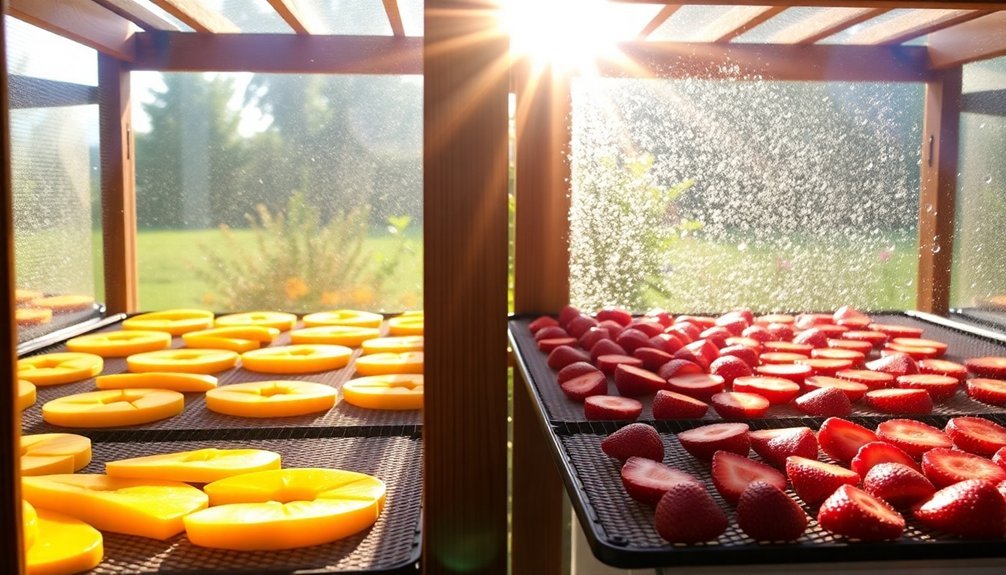
What's more, you're joining a movement that reduces dependence on fossil fuels while conserving water.
Your solar dehydrator will save roughly 1.5 billion gallons of water annually compared to conventional preservation methods.
Solar dehydration helps promote energy independence by reducing reliance on imported energy sources for food preservation.
It's a practical way to preserve your harvest's nutritional value without refrigeration, allowing you to enjoy seasonal foods year-round while minimizing your environmental impact.
Cost Savings and Economic Benefits
Beyond its environmental advantages, a solar dehydrator can greatly boost your financial well-being. You'll save markedly on construction costs by using locally available and recycled materials – with basic models costing less than $50. By harnessing free solar energy, you'll eliminate ongoing electricity or gas expenses typically associated with conventional dehydrators.
The economic benefits extend far beyond initial savings. You can transform your excess produce into valuable dried products, creating a new revenue stream that operates year-round. This means you'll reduce waste while maximizing your harvest's profit potential. With a typical lifespan of 10-15 years, your solar dehydrator provides exceptional long-term value with proper maintenance.
| Cost Savings | Income Opportunities |
|---|---|
| No utility bills | Sell dried fruits and vegetables |
| Cheap construction materials | Create premium snack products |
| Minimal maintenance costs | Year-round income potential |
| Reduced food waste | Value-added processing |
| Zero energy expenses | Market to health-conscious buyers |
With your solar dehydrator, you'll gain the flexibility to scale your operation based on seasonal harvests. Whether you're preserving food for your family or building a small business, the financial advantages make this investment particularly attractive, especially when you consider that you're using repurposed materials and free solar energy to generate income.
Sustainable Food Storage Solutions
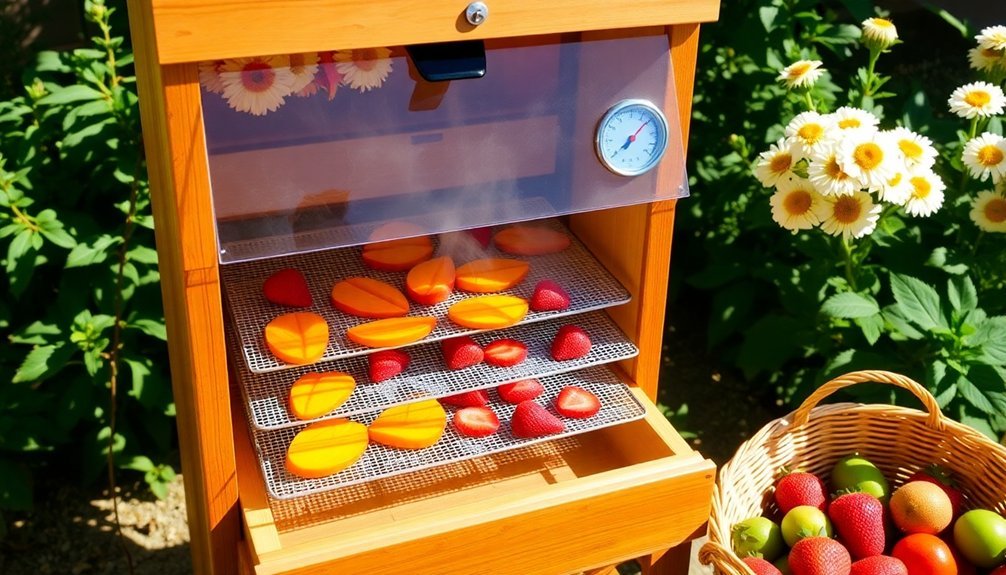
Smart storage solutions play an essential role in preserving your dehydrated fruits and vegetables. You'll want to choose containers made from sustainable materials that guarantee both food safety and environmental responsibility.
Glass containers offer excellent visibility and don't leach chemicals into your dried foods, while stainless steel options provide durability and don't harbor bacteria due to their non-porous nature.
For maximum longevity, consider investing in containers with silicone gaskets, like those from INKA, which can withstand 40 times more uses than standard containers. Made from Tritan Copolyester material, these containers are 70% stronger than traditional foodware. You'll find these sustainable options are dishwasher safe and work well in both freezers and refrigerators.
If you're looking for flexibility, silicone storage bags, like Stasher's products, offer a non-toxic, reusable alternative that's infinitely versatile.
When selecting storage solutions, opt for modular sizes that accommodate various portions of your dehydrated foods. Look for products from certified B Corps and companies that guarantee ethical production practices.
At the end of their lifecycle, these containers can be properly recycled through programs like TerraCycle, making them a truly sustainable choice for storing your solar-dehydrated produce.
Health and Nutritional Advantages
Solar dehydration stands out as a superior method for preserving food while maintaining its nutritional integrity. When you dry foods at low temperatures around 60-65 degrees Celsius, you'll preserve most of their nutritional properties and health benefits compared to fresh foods. The process effectively prevents the spread of microorganisms while keeping nutrients intact.
You'll appreciate how dehydration removes moisture, making it nearly impossible for bacteria, mold, and other harmful microorganisms to thrive. While this method won't eliminate all bacteria or toxins, it greatly reduces your risk of foodborne illnesses when you store the dried foods properly in airtight containers.
You can dehydrate almost any food type, from fruits and vegetables to mushrooms and herbs. Whether you're drying zucchini, tomatoes, or medicinal herbs for teas, you'll find this method incredibly versatile.
You'll even be able to preserve wood, flowers, and hay using the same solar dehydrator.
The benefits extend to storage and transportation too. You'll notice that your dehydrated foods become lightweight and compact while maintaining their shelf life for up to several years.
When you're ready to use them, simply rehydrate with water or steam to restore their original texture and nutritional value.
Building Your Solar Dehydrator
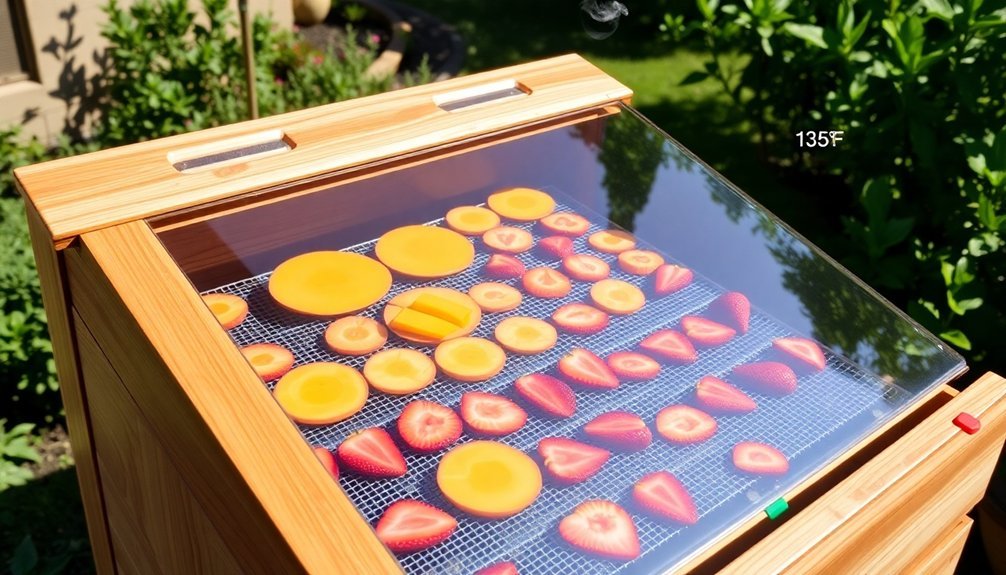
Building your own solar dehydrator requires several basic materials and careful attention to design principles. You'll need plywood or wooden planks for the frame, glass or clear plastic glazing for the top, and basic hardware like screws and nails. The design also requires screen mesh to keep insects out while allowing proper air circulation.
Start by constructing a frame using 2x4s around the plywood edges, then create a collector box with black-painted interior surfaces to maximize heat absorption. Install mesh trays in the drying chamber where you'll place your food items.
Don't forget to drill ventilation holes at both the lower and upper ends of the dehydrator, covering them with mesh to prevent insect entry while maintaining airflow.
You can build this project in 20-40 hours, depending on your woodworking skills. The total cost can be as low as $20 if you use recycled materials.
Add wheels and handles to make your dehydrator portable, allowing you to chase the sun throughout the day. Remember to position air intake holes at the bottom and exit vents at the top to create natural convection, which helps remove moisture from your food more effectively.
Optimal Placement and Setup
For your solar fruit dehydrator to work efficiently, you'll need to position it in a spot with maximum sun exposure throughout the day, away from any trees or structures that could cast shadows.
You'll want to face the collector towards true south if you're in the Northern Hemisphere, adjusting the angle to match your latitude and the season of use.
Remember to place your dehydrator on level, stable ground where it's convenient to access and can be properly anchored against strong winds.
Location and Sun Exposure
Successful fruit dehydration starts with choosing the perfect location for your solar dehydrator. You'll want to select a spot that receives maximum sunlight throughout the day while guaranteeing it's convenient for transporting your produce. Contemplate using smartphone apps to track the sun's path and identify the ideal placement that avoids shadows from trees, buildings, or other obstacles.
Your dehydrator's location should prioritize both functionality and stability. Choose level ground that's free from debris and close to your storage or processing areas. If you're planning a permanent setup, you can secure the dehydrator using pressure-treated lumber and concrete. For a mobile solution, place it on horizontal 4x4s and stake it firmly to the ground.
Here are three essential factors to reflect on when positioning your dehydrator:
- Peak sun exposure hours – align your dehydrator to maximize direct sunlight during the most intense solar periods
- Wind protection – guarantee proper anchoring while maintaining adequate ventilation
- Accessibility – position the unit where you can easily load, unload, and monitor your produce
Remember to keep the area around your dehydrator clean and organized, and always follow proper food safety practices during operation.
Angle and Direction Matters
Maximizing your solar dehydrator's efficiency depends heavily on its angle and directional orientation. You'll need to position your collector at an ideal angle based on your latitude – the farther you're from the equator, the steeper the angle should be. For instance, if you're in a tropical region, you might set it at 15 degrees, while locations like Stillwater, Oklahoma require a 54-degree angle.
In the Northern Hemisphere, you'll want to face your collector southward to capture maximum sunlight throughout the day. Use your smartphone's compass or solar position apps to confirm proper alignment with the sun's path. Don't forget to measure the angle counterclockwise from the vertical position, typically around 77 degrees for many configurations.
You should also plan for seasonal adjustments. Install telescoping legs or adjustable mechanisms to modify the collector's angle as seasons change. This flexibility guarantees consistent performance year-round.
When setting up, make sure your dehydrator is level and secure – use pressure-treated lumber and concrete for stability if needed. These precise adjustments in angle and direction will greatly impact your dehydrator's airflow and temperature, ultimately affecting your food's drying efficiency.
Avoiding Shadow Interference
Now that you've positioned your dehydrator at the ideal angle, finding the right location will make or break its performance.
You'll need to guarantee your dehydrator receives maximum sunlight throughout the day by carefully selecting a spot free from any shadows. Look for an area that's away from trees, buildings, and natural landforms that could block vital sunlight from reaching the solar collector.
To maintain peak performance, you'll want to:
- Remove all obstacles and trim any overhanging branches that might cast shadows on your dehydrator
- Secure your unit properly using pressure-treated 4×4 lumber and concrete for permanent installation, or stake it to the ground with horizontal supports
- Monitor the sun's path using smartphone apps to predict potential shadow interference throughout different seasons
Keep the surrounding area clear of new obstructions and consider using reflective materials like aluminum foil to enhance sunlight capture if needed.
Remember to position your dehydrator where it's easily accessible for maintenance and harvesting.
Year-Round Food Security
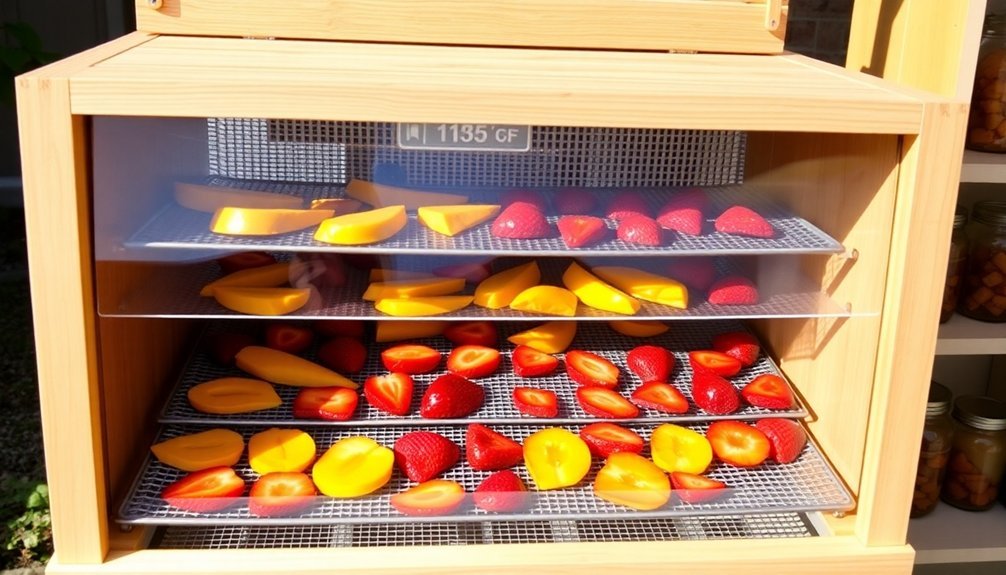
Your solar fruit dehydrator can transform summer's abundant harvests into shelf-stable foods that'll sustain you throughout the year.
You're no longer at the mercy of weather conditions when storing food, as properly dehydrated fruits and vegetables remain nutritious for months in airtight containers.
You'll appreciate having a reliable food preservation method that works independently of electricity or refrigeration, ensuring your family has access to healthy, preserved foods even during challenging times.
Preserve Summer's Bounty
Through the power of solar dehydration, seasonal produce transforms into shelf-stable treasures that you can enjoy all year long.
You'll find that solar dehydrators efficiently preserve your summer harvest without relying on electricity or fossil fuels, making them an environmentally conscious choice for food preservation. By harnessing the sun's energy, you're able to dry fruits, vegetables, mushrooms, and herbs quickly while retaining their essential nutrients and intense flavors.
When you build your own solar dehydrator, you'll discover three key advantages:
- Cost-effective preservation – You can construct your dehydrator using recycled materials like old glass jars or cardboard boxes, making it an affordable solution for managing harvest abundance.
- Nutritional retention – Your dried foods maintain their nutritional value, creating nutrient-dense snacks and ingredients you can use throughout the year.
- Versatile storage options – You won't need cold storage for your preserved foods, as they'll stay fresh at room temperature, enhancing your food security and providing a stable supply of healthy ingredients for various recipes.
Weather-Independent Food Storage
While traditional farming methods leave crops vulnerable to unpredictable weather patterns, modern approaches like vertical farming and solar dehydration provide reliable food security throughout the year. You'll find that solar dehydrators protect your harvest from dust, insects, and unexpected rain, while ensuring consistent food quality regardless of external conditions.
By building your own solar dehydrator, you're taking control of your food preservation process. It's a sustainable solution that operates independently of weather fluctuations, using passive solar heating to maintain steady drying conditions even on cloudy days.
| Traditional Methods | Solar Dehydration Benefits |
|---|---|
| Weather-dependent harvests | Year-round preservation |
| Crop loss from storms | Protected from elements |
| Inconsistent quality | Reliable results |
| High energy costs | Free solar power |
| Limited growing seasons | Preserve any season |
You're not just preserving food; you're investing in a weather-independent food storage system that'll serve you reliably throughout the year. With controlled drying conditions and protection from environmental contaminants, your dehydrated foods maintain their nutritional value and quality consistently. It's a practical step toward food security that works in any climate, any season.
Community Impact and Education
Solar fruit dehydrators serve as powerful catalysts for community engagement and education. When you build and operate one, you'll create opportunities for neighbors to come together, share resources, and learn valuable skills. Your project can transform surplus produce into a platform for hands-on learning about sustainable food preservation and renewable energy.
The educational impact extends beyond food preservation. You'll help community members develop practical skills while fostering environmental awareness. Through collaborative construction and operation, participants gain expertise in carpentry, solar energy applications, and project management.
You're not just building a dehydrator; you're creating a living classroom for sustainable practices.
Here are three key ways your solar dehydrator project impacts the community:
- Creates a hub for skill-sharing where people learn food preservation techniques, woodworking, and renewable energy principles
- Reduces local food waste by providing a solution for excess produce while teaching resource conservation
- Builds stronger community bonds through shared activities and collaborative learning experiences
Design Tips and Materials
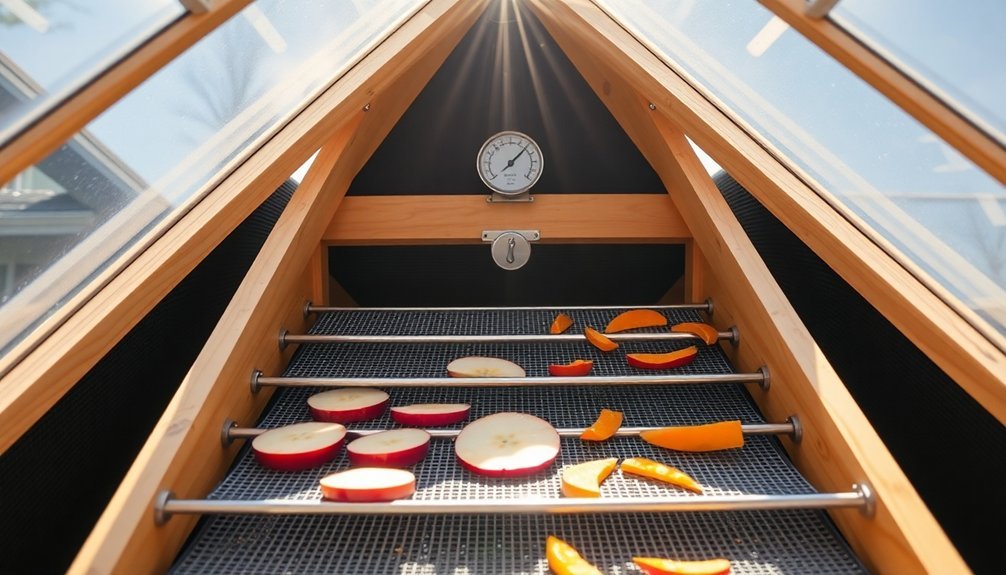
Creating an effective solar fruit dehydrator starts with smart design choices and proper material selection. You'll need to focus on four key elements: a glass-encased solar collector, proper air circulation, ideal sun angle, and mobility features.
Start with a rectangular plywood base and 2×4 lumber to build your frame. You'll want to make the glass cover slightly shorter than the base to guarantee proper fit. Use exterior-grade black paint on the solar collector chute to maximize heat absorption, and install food-safe stainless steel mesh for your drying trays.
Don't forget to drill air intake holes at one end to promote circulation. When assembling, you'll need to create an airtight seal using 100% silicone caulk for all seams and corners. Position your collector at the ideal angle using online solar calculators for your specific location.
If you're building a smaller unit, consider adding wheels for easy repositioning throughout the day. Remember to include proper ventilation paths that allow hot air to rise and cool air to exit. These design choices will guarantee your dehydrator operates efficiently and produces consistently dried fruits.
Frequently Asked Questions
Can Solar Dehydrators Work Effectively in Cloudy or Humid Climates?
Yes, you'll find solar dehydrators can work in cloudy and humid conditions, but they're less efficient. You'll need larger collectors, proper angling, and optimized ventilation to overcome these challenges and achieve successful dehydration.
How Long Does It Take to Master the Proper Food Preparation Techniques?
You'll need about 2-4 weeks of regular practice to master basic food preparation techniques. With consistent hands-on experience, you'll learn proper slicing, cleaning, and arrangement methods for ideal solar dehydration results.
What Safety Measures Prevent Insects and Birds From Contaminating Food?
You'll need to install food-safe screens over all openings, use double-layered glazing, and guarantee tight seals throughout your dehydrator. Keep food covered during processing and store it in airtight containers afterward.
Do Different Fruits and Vegetables Require Different Drying Rack Materials?
You'll find most fruits and vegetables dry well on the same materials. Just avoid copper, aluminum, and certain woods like pine or cedar that can affect taste or cause discoloration of your produce.
Can Solar Dehydrators Be Safely Used for Drying Meat Products?
You shouldn't use basic solar dehydrators for meat due to food safety risks. They don't maintain consistent temperatures needed to prevent bacterial growth. Stick to electric dehydrators or specialized meat-drying equipment instead.
In Summary
By building your own solar fruit dehydrator, you're taking control of your food preservation while reducing your carbon footprint. You'll save money, create healthy snacks, and have access to nutritious food year-round. Whether you're a gardener, homesteader, or eco-conscious consumer, this sustainable solution offers independence from commercial processing. Start your solar dehydrating journey today and join a growing community of self-sufficient food preservers.

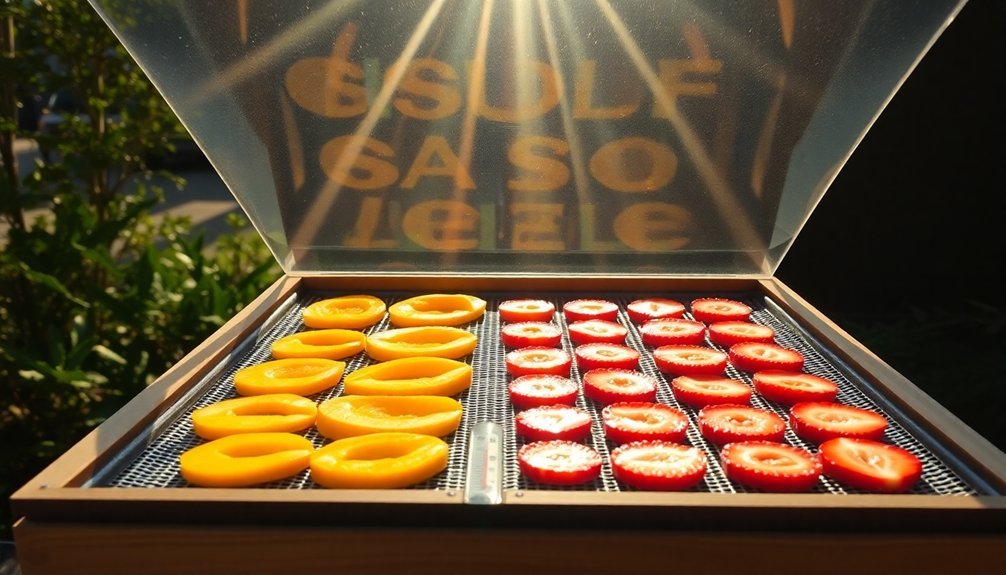



Leave a Reply